Best Practices of Full Depth Reclamation
BY AsphaltPro Staff
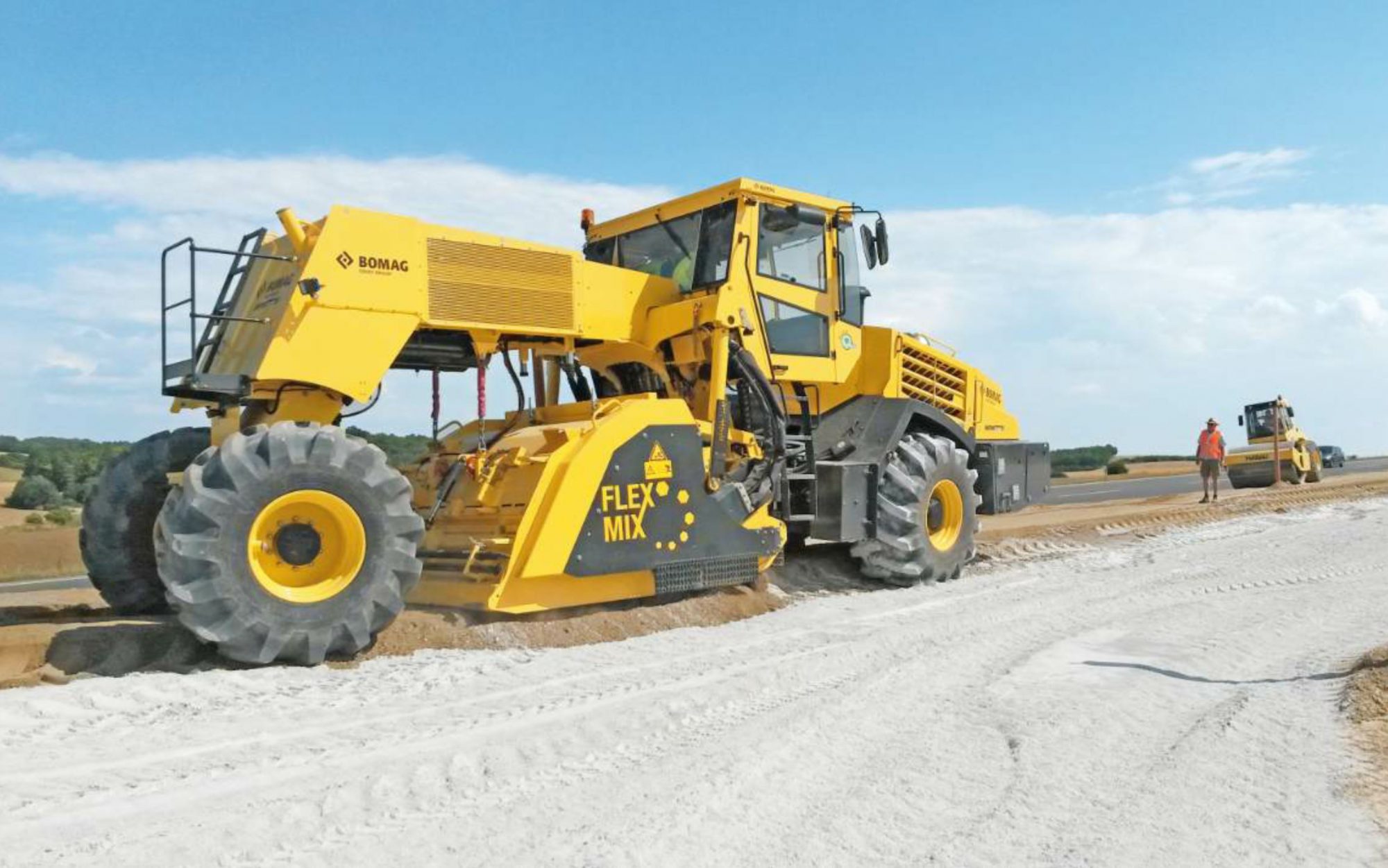
Full depth reclamation (FDR) is the process of pulverizing and blending all layers of an asphalt pavement in-situ, as well as part or all of the underlying base materials to provide a homogenous material upon which to place a surface course.
“FDR has been growing in popularity over the past eight to 10 years,” said Product Application Specialist Anthony Low at Caterpillar, Peoria, Illinois. He mentioned its benefits include minimal traffic disturbance, environmental friendliness, minimal use of virgin material and being an economical alternative to some other pavement preservation methods.
“The material in place for an FDR project has already been paid for, so working with existing material is often times more cost effective,” said Matt White, North American sales manager for milling and R/S products at BOMAG Americas, Ridgeway, South Carolina. FDR is best suited, White adds, for situations where base failures have occurred, or increased bearing capacity is desired. “By combining the layers, you create a homogenous layer which is either strengthened by mechanical, chemical or bituminous stabilization.” He estimated that more than 90 percent of FDR includes the addition of a chemical or bituminous binding agent.
You can read full discussions of these methods here, but here are a few quick definitions.
- Pulverization of a failing pavement is the most basic FDR application, according to the team at Wirtgen America Inc., Antioch, Tennessee. If the end use for the recycled pavement is a low-volume road or a parking lot with no foundation deficiencies, after an engineering analysis, simple pulverization and compaction with surface treatment likely will suffice. For a stronger pavement, mechanical, chemical or bituminous stabilization is integral to FDR. Dedicated stabilization of the recycled material will provide a more robust pavement. “The most important part of FDR is stabilization,” said Mark Stahl, director of recycling products for Wirtgen America. “It’s stabilization of the reclaimed layers which gives the pavement foundation the structural strength to withstand repeated loads for decades.”
- Mechanical stabilization is the next step up from pulverization, for use on low to medium volume pavements with simple surface and base defects, according to the Wirtgen team.
- Chemical stabilization is achieved with the addition of binding agents such as lime, portland cement, cement kiln dust, calcium or magnesium chloride, or fly ash. This can be achieved by distributing the dry material on the existing pavement in advance of the recycler, or as slurry, fed into the recycler or placed on the existing pavement.
- Bituminous stabilization utilizes asphalt emulsion or foamed asphalt, and is indicated for medium to high traffic roadways. It’s a cost-effective method of improving the strength of reclaimed pavement while reducing the effects of moisture, is more flexible than base courses that utilize chemical stabilizers, offers superior fatigue resistance, and is not prone to cracking, according to the Asphalt Recycling & Reclaiming Association (ARRA).
White said FDR differs from rehabilitation techniques such as cold-planing, where material is removed and typically paved back with virgin material, and hot in-place recycling (HIR), where repairs are commonly made to failures that emanate from the top asphalt layers. Experts maintain that in each field application, a recycle process should be determined after an engineering investigation and material tests. That way the “right treatment for the right road at the right time” is assured.
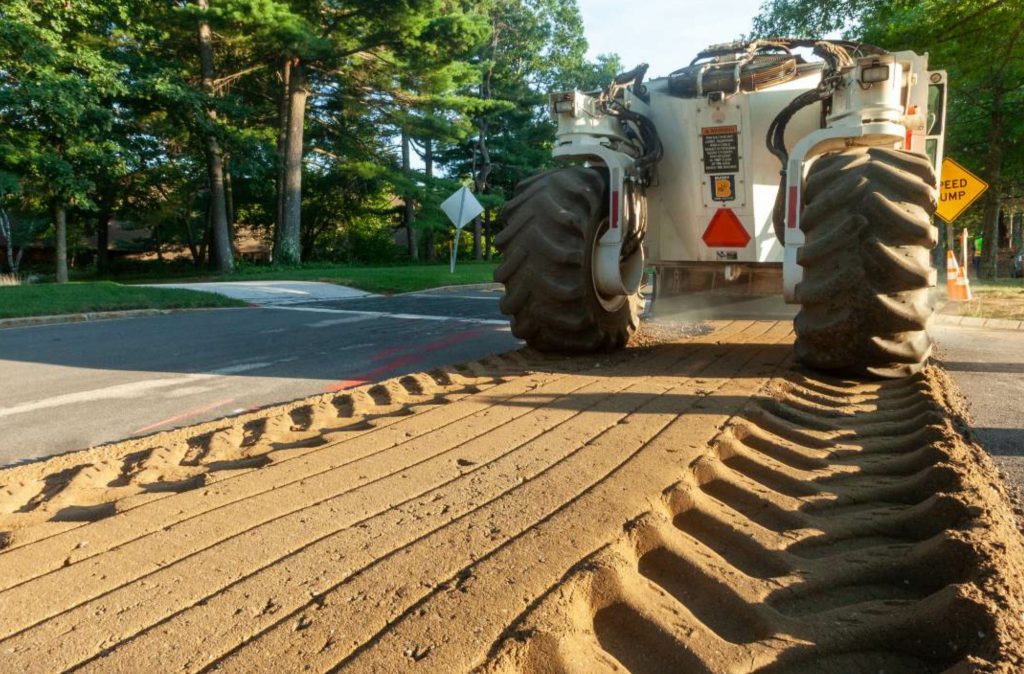
Experts maintain that in each field application, a recycle process should be determined after an engineering investigation and material tests. That way the “right treatment for the right road at the right time” is assured. Photo courtesy of Roadtec
“Full depth reclamation addresses issues with subgrade stability, surface integrity, and various forms of cracking and rutting,” said Kyle Hammon, product manager for milling machines and stabilizer-reclaimers at Roadtec Inc., Chattanooga. “In applications where pavement distress is within the treatment depth or slightly below, the treatment’s life expectancy should fall in the 15- to 25-year range.”
Although newer equipment makes it possible to treat material at greater depths, typically found on higher volume roads, Hammon said it should be noted that FDR cannot treat deep subgrade instability.
Determine the Depth
The FDR process may require blending of some or all of the underlying base material. The exact amount depends on the structural and load bearing capacity desired by the road owner, White said.
If the existing material doesn’t meet load bearing requirements, it may need to be removed and supplemented with stronger material. White said material may also need to be removed to meet height requirements—matching the curb or existing structures, for example.
“Contractors must ensure that when doing this, they do not remove good material,” White said. “For example, you wouldn’t want to remove 4 inches of asphalt and leave only base material behind. Pre-pulverization to blend materials evenly and then removal of excess material would be preferred.”
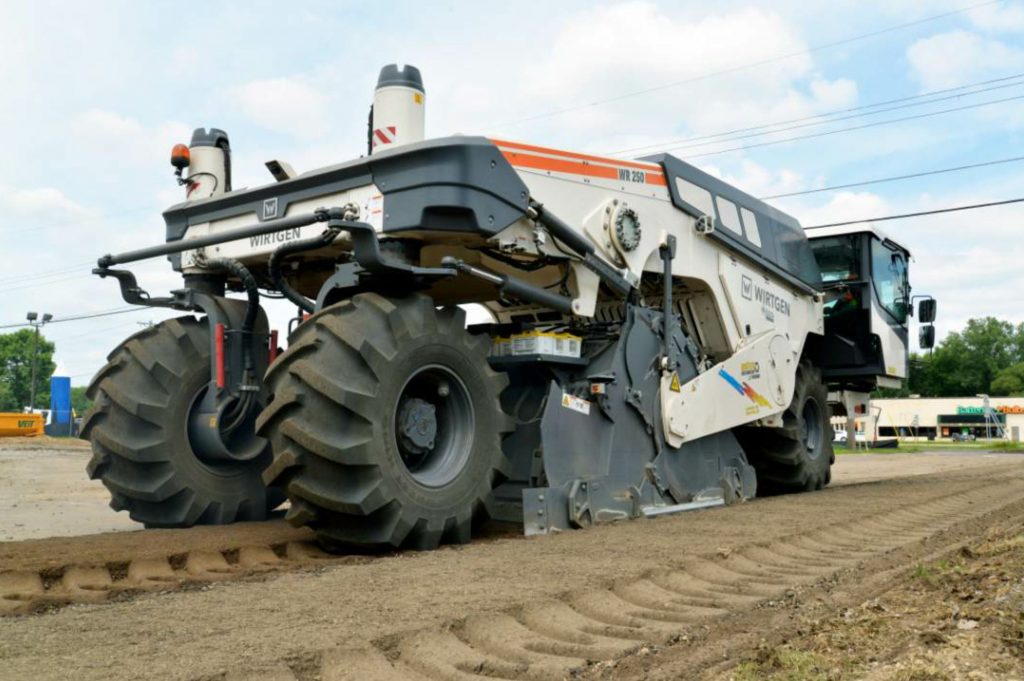
If the pavement has structures such as curbs, sidewalks or bridges that require the finish grade to be at a set height, a contractor can pre-mill the pavement to remove material prior to pulverization or remove the material after the recycle process is complete, before the wearing course is installed. Photo courtesy of Wirtgen
According to the Full Depth Reclamation Construction Checklist prepared by the Federal Highway Administration (FHWA), Foundation for Pavement Preservation (FP2 Inc.) and ARRA, cores should be taken from the center and the edge of the roadway in various locations throughout the length of the project to verify thickness of materials.
These samples should be evaluated for consistency over the length of the job.
“Because FDR work is not a controlled process such as creating asphalt, the in-situ material conditions can change very quickly,” White said. “Any indications the contractor has ahead of time will allow him to make proactive changes, rather than reactive change.”
For example, if the contractor knows there is a thin layer of pavement/base/subbase in a particular area, the crew can raise the cutter drum to prevent pulling up subgrade material into the mix.
Mix designs for FDR are almost always required, due to inconsistencies in road materials and varying traffic indexes, White said. If previous investigations have found a consistency of materials in the same areas of a county or city, a single mix design may suffice. However, White cautions this approach, due to irregularities that may exist due to in-situ moisture changes, gradation of existing material, age of asphalt and other factors.
Evaluation of the subgrade with either the falling weight deflectometer or dynamic cone penetrometer tests, measurement of existing slope/cross, and verification of thickness and consistency of the material with ground penetrating radar may be performed.
This phase of the project should also be used to identify all buried structures that could present a safety hazard during the FDR process.
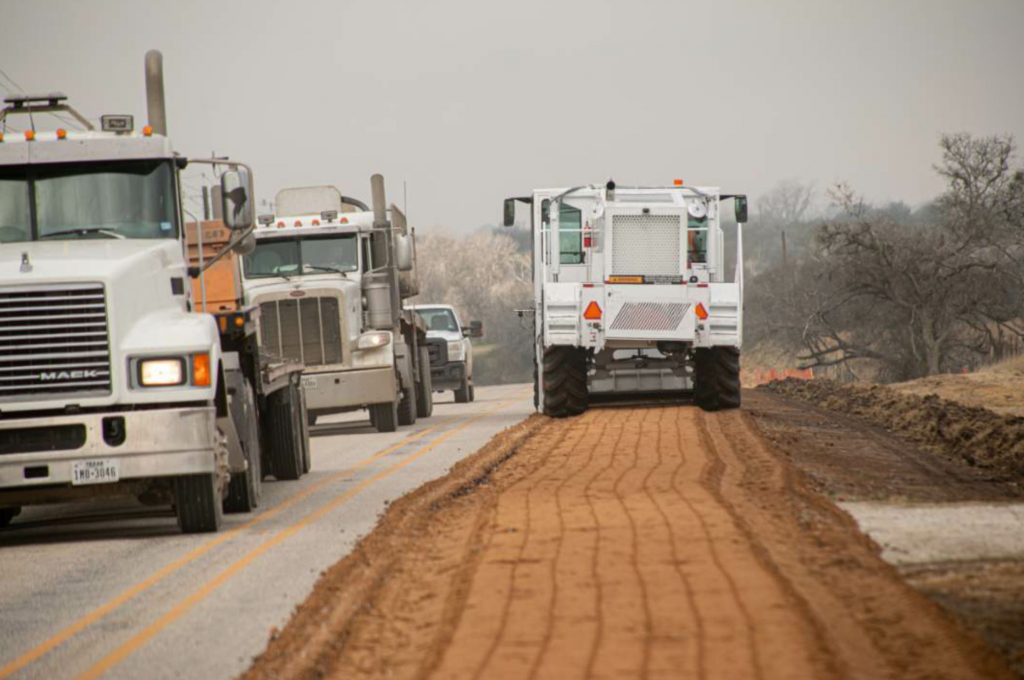
Photo courtesy of Roadtec
Wirtgen’s Stahl said FDR can reduce the impact on underground utilities, compared with remove-and-replace methods, as FDR is typically performed at a set depth.
“When remove and replace is chosen, digout tends to be less predictable and often deeper because you’re digging down to find stable material. Therefore, contractors are more likely to get into utilities,” Stahl said. “With FDR, if a pipe is18 inches below grade and you’re doing FDR at a depth of 12 inches, there will be a 6-inch buffer.”
However, buried structures can still present a safety hazard during the FDR process. All buried items, from utilities and manholes to rail lines and valves, should be identified, removed if not in use, and clearly marked at the job site. White recommends lowering existing utilities at least 4 to 6 inches below the mixing depth and then covering them.
Low adds that FDR can reduce impact on utilities after its completion. “A well designed FDR mix will allow better axle load to be evenly spread over the sub-grade,” he said. “This will reduce the amount of pressure acting on underground amenities.”
Pulverize and Prep
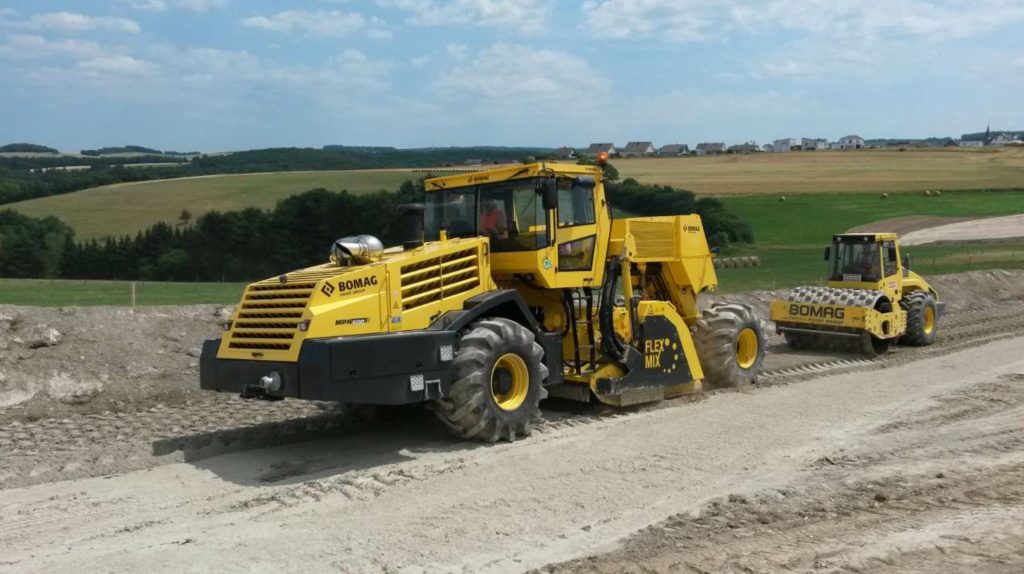
Photo courtesy of BOMAG
The process of FDR includes the pulverization of the material with a reclaimer in one or multiple passes. Prior to pulverization, standing water and vegetation on the pavement should be removed.
Pre-milling may also be required ahead of pulverization to accommodate for “fluffing up” or “bulking” of the material. According to Stahl, the exact amount of bulking depends on the materials present, but is generally 10 to 15 percent of the material’s volume.
Let’s assume the average asphalt pavement has 4 percent air voids. During the pulverization and compaction process, the finished product has between 9 and 12 percent voids. Once the process is completed, the new material will not fit in the same volumetric space, Stahl explained.
If the pavement has structures that require the finish grade to be at a set height, such as curbs, sidewalks or bridges, a contractor can pre-mill the pavement to remove material prior to pulverization or remove the material after the recycle process is complete, before the wearing course is installed. According to Stahl, most contractors opt to pre-mill.
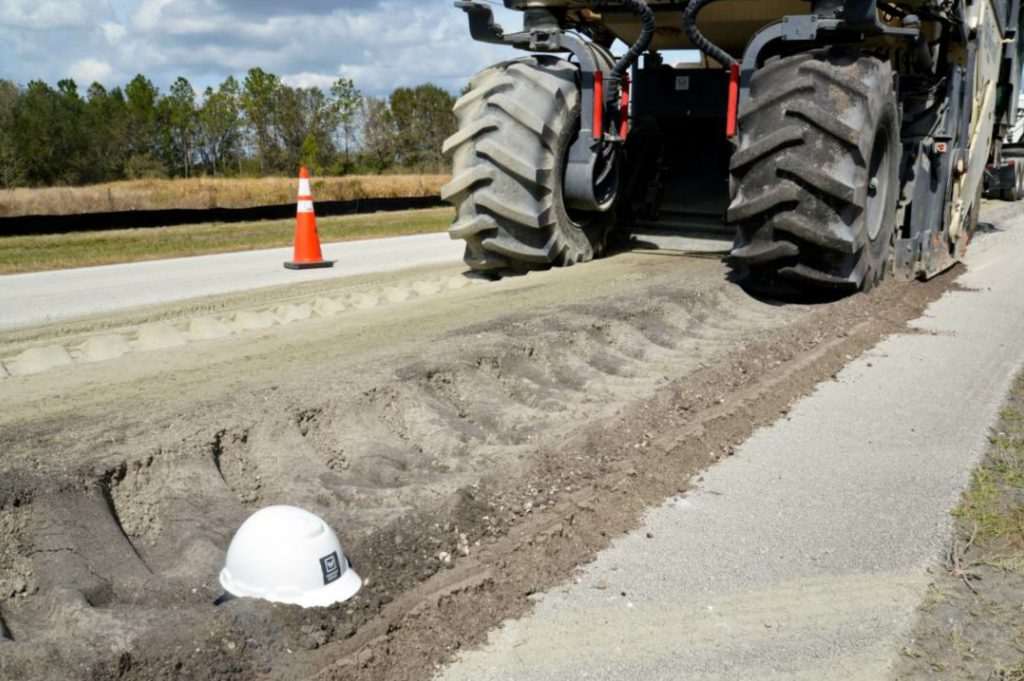
Photo courtesy of Wirtgen
Stahl also emphasizes the importance of performing a mix design on all FDR projects to ensure the appropriate binding agent is used at the correct amount and verify how deep to go to get the best results for the specific materials present.
“The mix design is like a recipe to get the desired results,” he said. “If work is performed without a mix design, you’re shooting from the hip.”
In Stahl’s experience, FDR is almost always accompanied by stabilization methods. For more information on best practices of soil stabilization, check out “How to Perform Base Stabilization” on theasphaltpro.com.
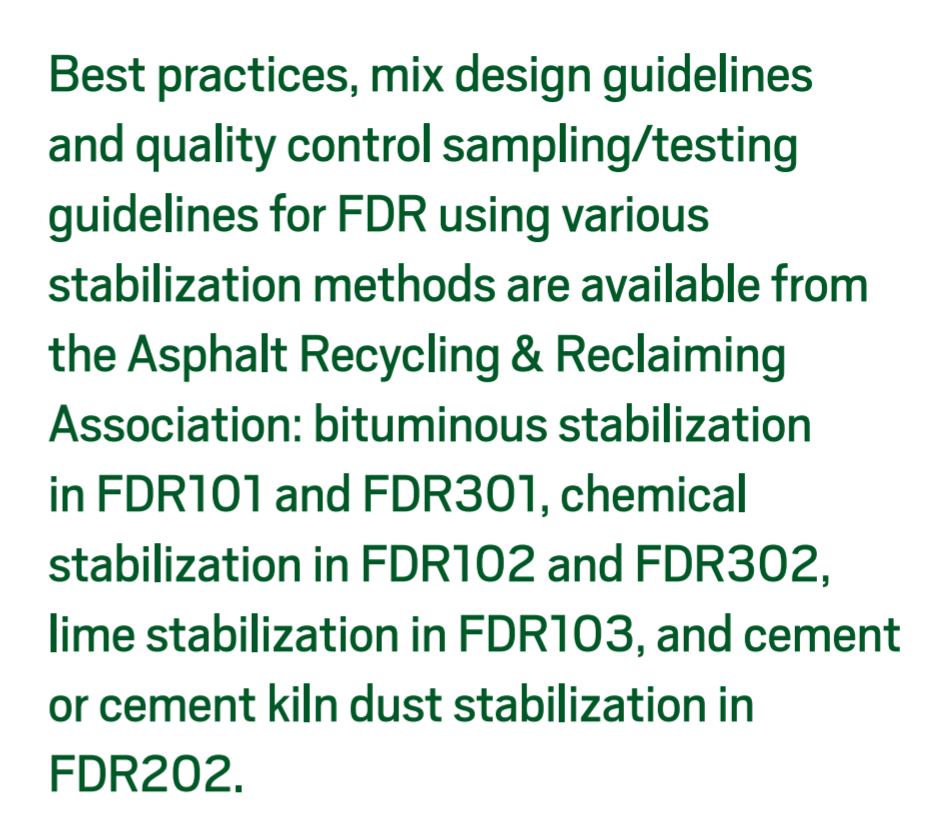
When pulverizing, verify the depth and gradation of the reclaimed material meets specs, and make sure the pulverized material is consistent with the cores provided. It may also be necessary to remove and replace some areas to ensure consistent materials throughout the project.
If there are oversized chunks of material after pulverizing, closely monitor the speed of the reclaimer, check and replace worn teeth, and remove any visibly oversized materials prior to compaction.
During the pulverization process, Stahl recommends overlapping the longitudinal joint by 6 inches to ensure all pavement material is processed and not missed. He also recommends an overlap of 3 to 5 feet at the transverse joint to avoid rough transitions.
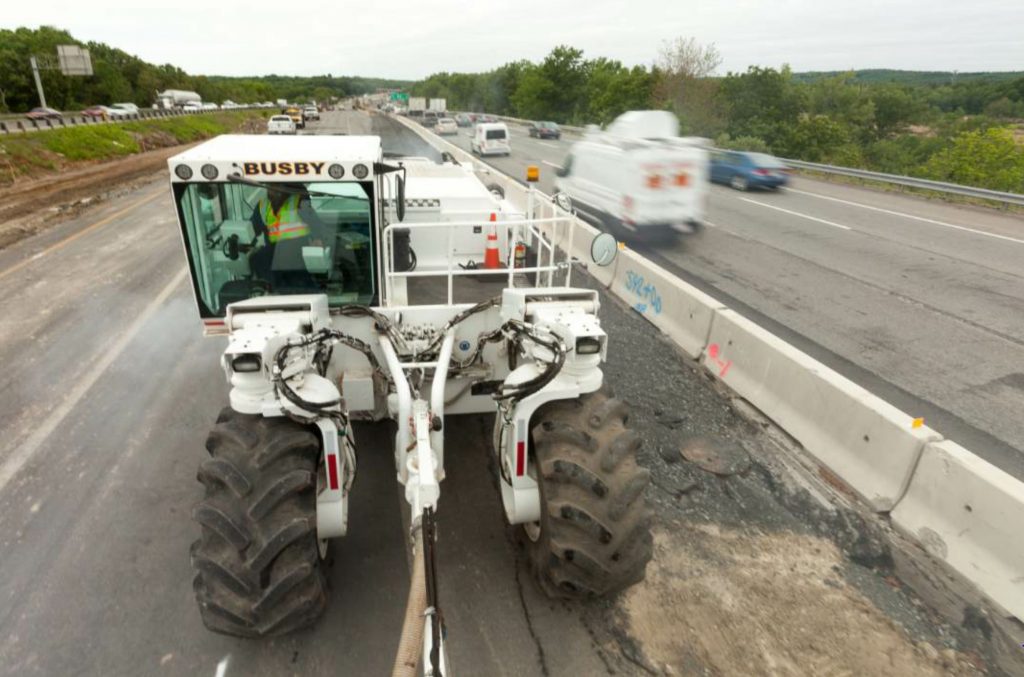
Full depth reclamation offers a number of benefits, including minimal traffic disturbance, environmental friendliness and minimal use of virgin material. Photo courtesy of Roadtec
“If the machine starts at the exact place it stopped the day before, there will be a rough area there,” he said. “It’s similar to asphalt paving where extra care needs to be taken to ensure a smooth transition.”
Low said this is one best practice that hasn’t become common practice—yet.
“To minimize lateral and linear cracks, good overlaps should be done within two to three hours, to allow homogeneous curing,” Low said, adding that he recommends a minimum end of cut of roughly 8 inches, as well as an overlap of 5 to 6 ½ feet. “End of cuts are usually left staggered in order to minimize lateral cracks across the road.”
It’s also important to verify the moisture content of the material and adjust as needed. According to White, moisture content can be referenced on-site or in a lab by using various methods provided by the American Association of State Highway Transportation Officials (AASHTO) or ASTM.
“Moisture reference is usually noted by an experienced hand in the field feeling and seeing the material, as well as establishing a moisture-density curve by setting a rolling pattern,” White said.
Achieving the optimal moisture content (OMC) is key to compaction success. Too little moisture can prevent proper compaction since the material won’t have enough lubricity to push out air voids. Too much moisture will cause delayed strength and pumping, when there is so much water in the material that, when pushed down, the water will push up other areas.
Water may be applied via the reclaimer’s on-board additive system or with a separate water truck. The water truck will also supply the reclaimer with water. Calibration on application rates of any equipment delivering water (or other additives) should also be performed, Hammon said.
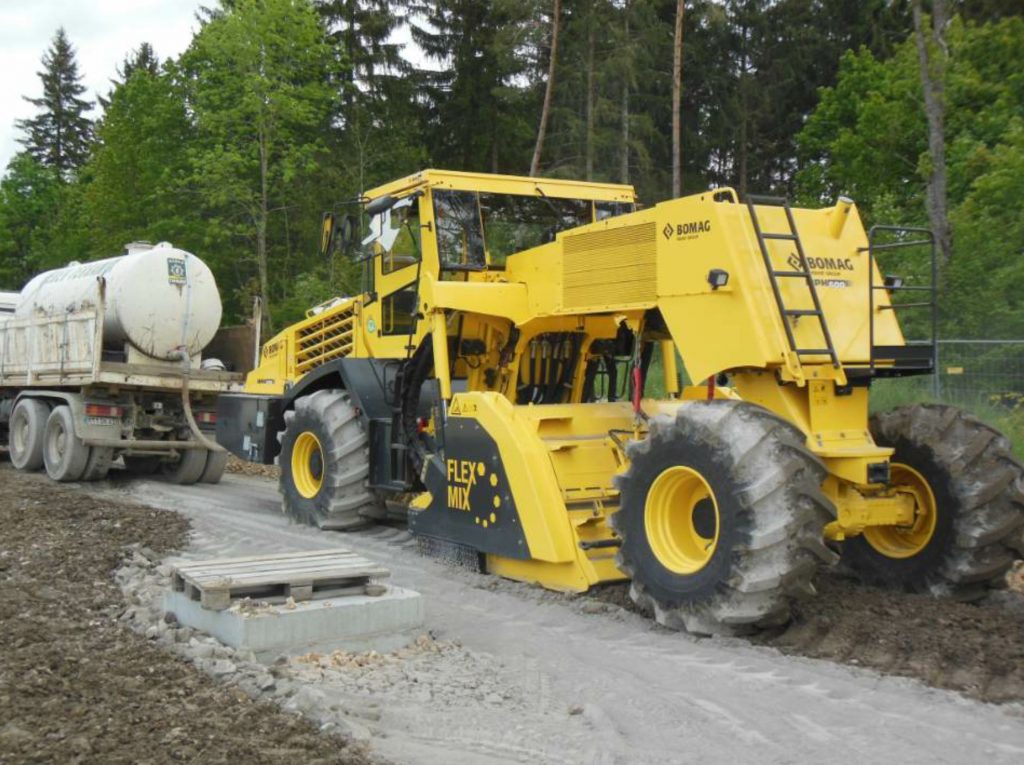
Photo courtesy of BOMAG
According to RoadResource.org, an online resource prepared by the Pavement Preservation and Recycling Alliance, if the material is above optimum moisture content, the contractor may consider one of the following solutions: change the rolling pattern, use a pneumatic tire roller or pad-foot roller instead of a steel wheel roller, revise the stabilizing agent used, check for subgrade instability or use less water.
“In some cases where you are over OMC, you may be able to aerate the material by opening it up with the stabilizer,” White said. “The more you handle, the more you can remove moisture, but you also have to be aware of segregating the material and/or breaking the bonds if using a binder.”
If moisture content is inconsistent, check for clogged spray bars or investigate potential gradation changes and adjust the application rate accordingly.
It should be noted that FDR should not be performed in rainy conditions, as this will add uncontrolled moisture that can affect curing time of the binder agent and compatibility. FDR should also be postponed if the pavement is frozen or freezing temps are forecast within a week after reclamation.
“Low or near freezing temps can create issues with curing, whether utilizing cement, emulsion or foam,” White said. “This can result in a myriad of issues, from late strength gains to problems with binder dispersion, which can ultimately lead to areas of failure and delayed trafficking.”
Additional weather requirements may be specified, depending on other project factors.
Grade and Compact
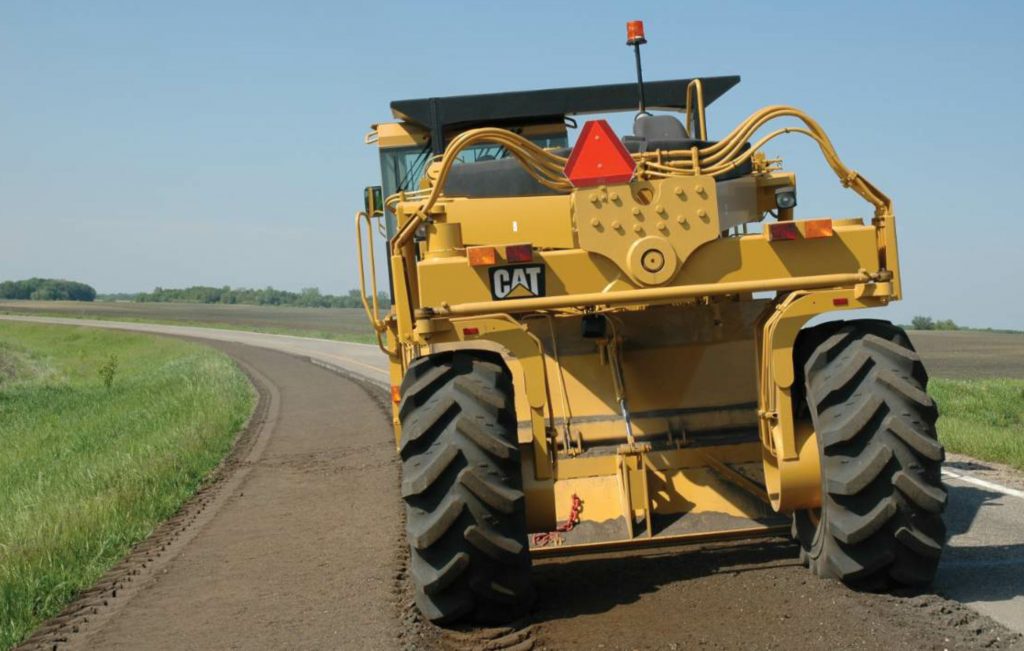
It is important to give the reclaimed surface sufficient time to cure before being opened to traffic. Photo courtesy of Caterpillar
After an initial pass with the reclaimer, the material should be bladed and compacted. White recommends initial compaction directly behind the stabilizer to establish “deep compaction” first, followed by the grader to shape the material.
One of Stahl’s top best practices is to ensure the grader blade is cutting deep enough to remove the imprints left by the pad-foot roller and that the material is put on grade in as few passes as possible. “If the material is overworked, it can dry out and cause problems,” he adds.
“If a stabilizing agent is used, it is typically added during a second ‘mixing’ pass made with the reclaimer,” Hammon said. “After the mixing pass, the material should be bladed and compacted again. Finally, the material is trimmed to final grade.”
After shaping is complete, compaction can be performed by one or more pneumatic, smooth single drum or double drum vibratory rollers. White suggests a double-drum or rubber-tire roller for final compaction of the top surface. “Typically, a rubber-tire roller will finish off the surface to bring the fines and moisture to the top, creating a ‘sealing effect,’” he said.
An adequate roller pattern should be established early.
“Proper compaction is necessary not only for density, but to allow the material to cure faster and gain sufficient strength,” Hammon said.
Compaction should be monitored regularly using a nuclear density gauge and the finished surface grade should be checked regularly using a 10-foot straightedge.
Depending on whether one performs chemical, mechanical or bituminous FDR, White said lab testing may consist of unconfined compressive strength (UCS), indirect tensile strength (ITS), optimum moisture content (OMC), or dry density, among others.
“In the field, density, moisture testing, FWD [falling weight deflectometer] and coring samples can be performed,” White said.
Cure and Cover
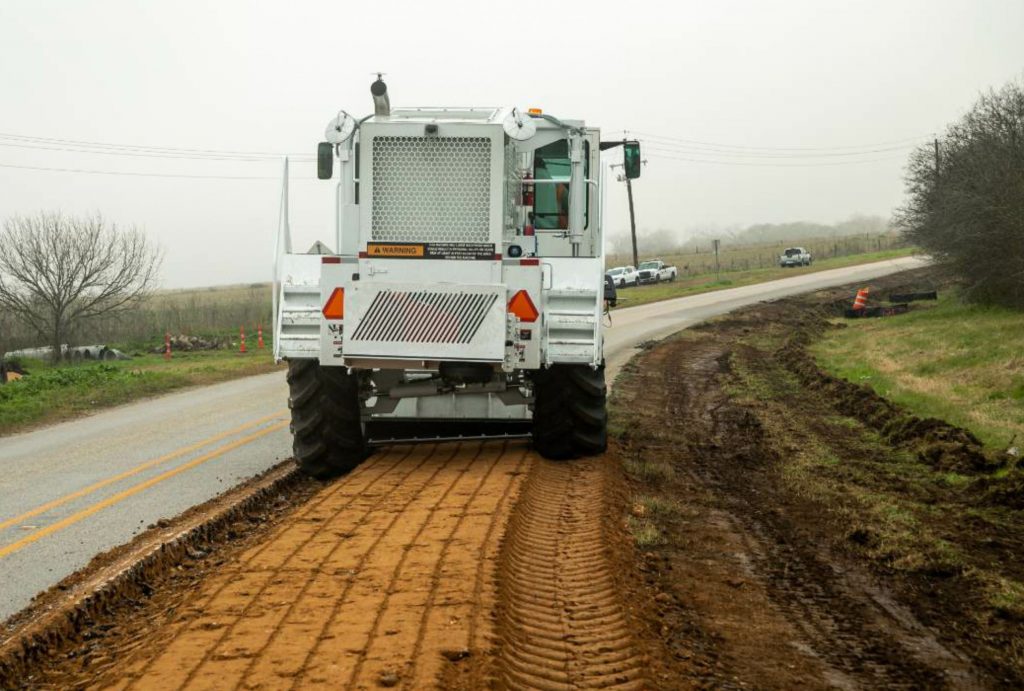
Photo courtesy of Roadtec
According to White, FDR methods of stabilization often allow for “quick in and out work,” which reduces the impact on highly trafficked roads.
“High-horsepower machines can work thousands of square yards per day up to depths of around 24 inches (if necessary),” he said. “A very thick, strong layer of recycled material with great load bearing capacity can now be created in-situ and trafficked, many times, within a few hours of processing.”
However, it is still important to give the reclaimed surface sufficient time to cure before being opened to traffic. Curing time will depend on the type and amount of binding agent being used, ambient temperatures and moisture content, White said. Proof rolling the surface before opening it to traffic can help verify that it is ready to support light traffic.
“For emulsion, this is also dependent on how the emulsion was engineered (slow, medium or fast set),” he said. “With cement, foam and emulsion, the mat may have reached density, but can still be ‘tender’ for several hours.” However, cure time is one of many factors that must be examined when determining which stabilization agent to use.
However, cure time is not the only factor when determining which stabilization agent to use.
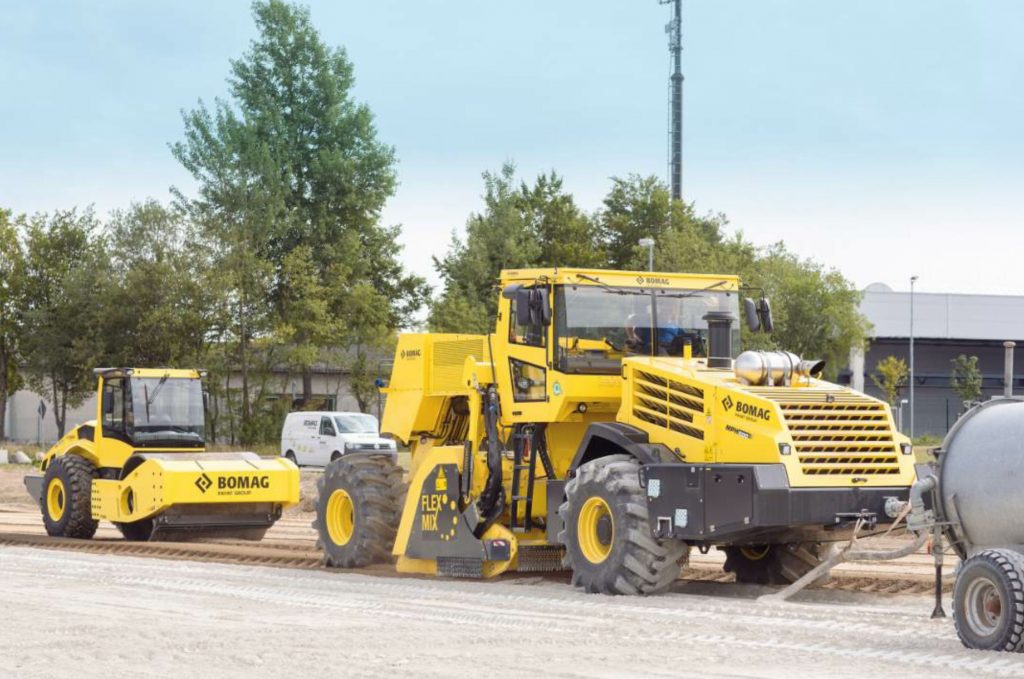
Photo courtesy of BOMAG
White added that if a surface must be opened to traffic prior to a fog seal, speeds should be limited.
“You may be okay to open traffic, but it’s a gamble many times, as this material is not designed to withstand scrubbing/shearing effects and high speeds as a wearing course is,” White said. “So in reality, a fog seal is like cheap insurance for all the hard work and money that has been put into securing a strong foundation.”
The condition of the reclaimed surface should be closely monitored after being opened to traffic prior to the surface course application. If the reclaimed material is disturbed by traffic, it will need to be resolved before the application of the surface course. Minor raveling or scuffing should be swept up and monitored, major raveling or scuffing should be re-recycled or repaired with asphalt mix.
After the reclaimed area has cured, a surface course may be applied. Common surface courses include a single or double chip seal, micro surface, slurry seal, hot mix overlay or cold mix overlay.
Sources:
“Basic Asphalt Recycling Manual, Second Edition,” prepared by the Asphalt Recycling & Reclaiming Association
“Full Depth Reclamation PDF presentation,” prepared by the Asphalt Recycling & Reclaiming Association
“Full Depth Reclamation Construction Checklist,” prepared by the Federal Highway Administration, Foundation for Pavement Preservation and Asphalt Recycling & Reclaiming Association
RoadResource.org’s Treatment Resource Center, prepared by the Pavement Preservation and Recycling Alliance
Matt White, North American sales manager for milling and R/S products at BOMAG Americas
Anthony Low, product application specialist at Caterpillar
Kyle Hammon, product manager for pavers and material transfer vehicles at Roadtec Inc.
Mark Stahl, director of recycling products at Wirtgen America
